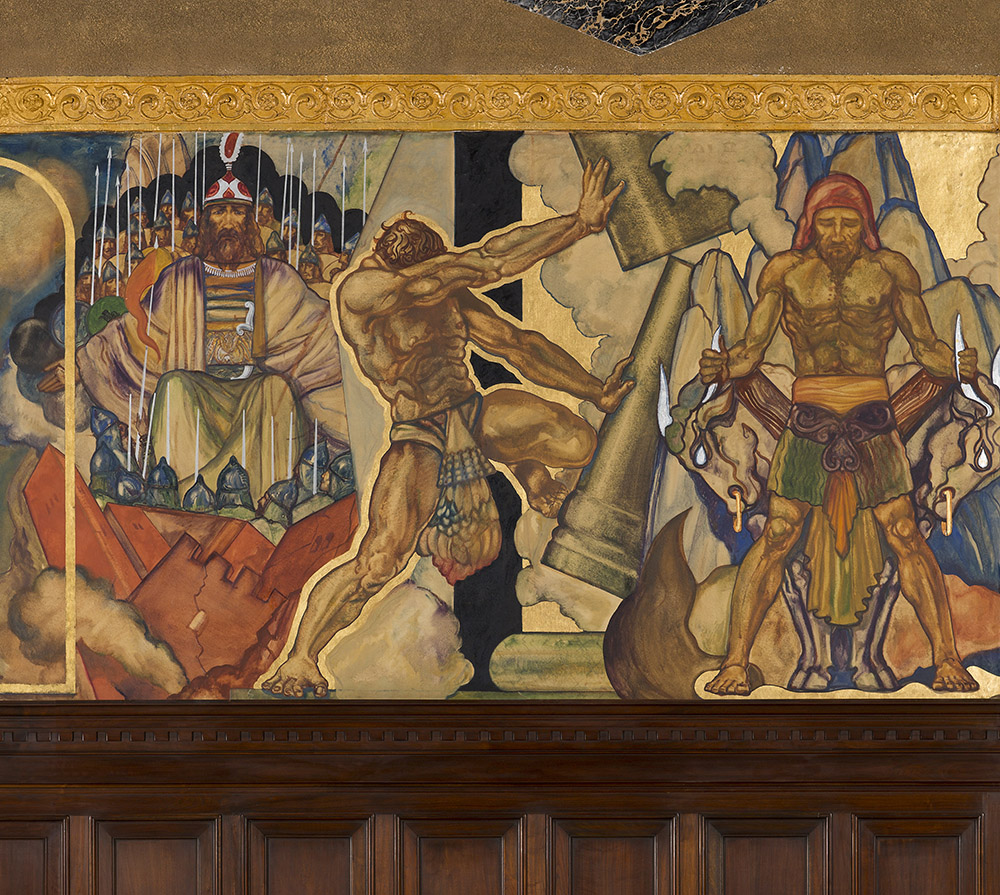Wilshire Boulevard Temple - Joshua, Samson, and Saul

- In Magnin's Words
- Cinematic Influences
- Source/Citations
Rabbi Edgar F. Magnin described Ballin's murals in a book published in 1974:
"On the right of the tablets are Joshua and his soldiers carrying their spears and below him are the walls of Jericho tumbling.
The next figure represent Samson pushing down the pillars of the Temple of Dagon. The figure is one of great physical strength. To the right, one sees Saul between the oxen, in accordance with the passage beginning with the fifth verse of the eleventh chapter of the first book of Samuel: "And, behold, Saul came following the oxen out of the field; and Saul said: 'What aileth the people that they weep?' And they told him of the words of the men of Jabesh. And the spirit of God came nightly upon Saul when he heard those words, and his anger was kindled greatly. And he took a yoke of oxen, and cut them in pieces, and sent them throughout all the borders of Israel by the hand of messengers, saying: ' Whosoever cometh not forth after Saul and after Samuel, so shall it be done unto his oxen.'
Saul is one of the most picturesque figures of the Bible. He possessed great courage. The latter period of his life was characterized by an affliction of melancholia has been beautifully treated by Robert Browning in his famous poem named after him."
"On the right of the tablets are Joshua and his soldiers carrying their spears and below him are the walls of Jericho tumbling.
The next figure represent Samson pushing down the pillars of the Temple of Dagon. The figure is one of great physical strength. To the right, one sees Saul between the oxen, in accordance with the passage beginning with the fifth verse of the eleventh chapter of the first book of Samuel: "And, behold, Saul came following the oxen out of the field; and Saul said: 'What aileth the people that they weep?' And they told him of the words of the men of Jabesh. And the spirit of God came nightly upon Saul when he heard those words, and his anger was kindled greatly. And he took a yoke of oxen, and cut them in pieces, and sent them throughout all the borders of Israel by the hand of messengers, saying: ' Whosoever cometh not forth after Saul and after Samuel, so shall it be done unto his oxen.'
Saul is one of the most picturesque figures of the Bible. He possessed great courage. The latter period of his life was characterized by an affliction of melancholia has been beautifully treated by Robert Browning in his famous poem named after him."
Notable here is the sense of movement and action in Ballin's representation of Joshua, Samson and Saul. Ballin uses a technique from set design, dividing the plane into three separate, fragmented ones with the figure of Samson breaking through as he tears down the pillars of the Temple of Dagon. Although the figures of Joshua and Saul are not themselves in action, the scenes around them seem in movement, action that they are controlling through their strength and power. Ballin again uses their body positioning and staging to convey aspects of their characters: Saul's "melancholia" comes through in his downward cast expression, Joshua's power as a leader projected in his strong, resolute posture and Samson's strength underscored in his physicality and muscular build. By positioning the figures in this way and placing them in these dynamic settings, Ballin offers three miniature scenes that together form a montage-like sequence, propelling his story forward.
Caption from Rabbi Edgar F. Magnin's book, The Warner Murals in the Wilshire Boulevard Temple, Los Angeles, California, published by the Wilshire Boulevard Temple, 1974.
| Previous page on path | Wilshire Boulevard Temple - Gallery, page 3 of 12 | Next page on path |

Discussion of "Wilshire Boulevard Temple - Joshua, Samson, and Saul"
Add your voice to this discussion.
Checking your signed in status ...